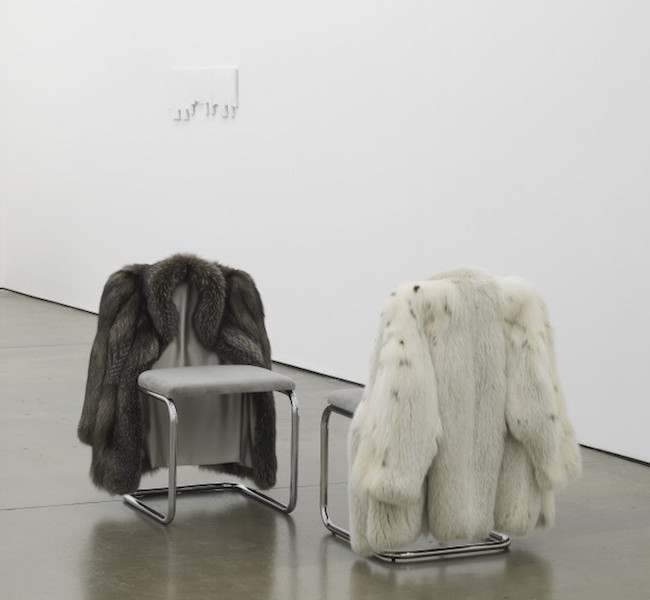David Bussel is a writer and independent curator. The following is his essay about Nicole Wermers’ exhibition, Infrastruktur, at Herald St. (London, February 25 — April 12, 2015). Wermers was born in Emsdetten, Germany and lives in London today.
Above image: Installation images courtesy of Herald St, London and copyright by the artist.
Things have structure but they do not all have infrastructure, the material or immaterial, visible or invisible, elements from which things can be produced, organized and systematized. Infrastructure is also a network of relations, an apparatus – it functionalizes things but instrumentalizes them as well. We can speak of infrastructure as a support structure in that it creates and distributes goods and services such as natural resources, transport, space, telecommunication and information technologies; we can also describe it as a regulatory or disciplinary structure, in that it produces and reproduces social relations through laws, the economy, education, planning, culture and so on, where both aspects in combination generate variable forms of value.

Nicole Wermers’ exhibition Infrastruktur (‘Infrastructure’) looks at the structures of ritualized social relations in general and at the material objects through which these relations are communicated in particular. Although the two bodies of work on view are formally and physically distinct – they do not form an installation as such – they are structurally not dissimilar in that they comprise legible objects that have been reassembled or made anew in a different material form, re-contextualizing their location-specific orientations from where transient acts and exchanges have been made into fixed concrete form.

Untitled Chairs (2014-15), is a series of unique dining chair and fur coat assemblages where the individual garments are seamlessly and permanently sewn around a chair’s form creating an entirely new one. The chairs themselves are Wermer’s adapted versions of a model created for German manufacturer Thonet in 1928 by architect and furniture designer Marcel Breuer, twentieth century ‘design classics’ that are still in production today. The Cesca chairs integrate a cantilevered tubular steel form with a cane or upholstered seat and backrest. These have now been conjoined with women’s furs in various styles and color, whose folds and visual allure boldly disport themselves coupled with additional silk linings and matching iridescent velvet seats, rendering the upright steel frame and cane back support entirely hidden from view. The coats hang as if their owners had left the room, a coded fleeting ritual marking their absence and their ‘ownership’ of the chair and its ‘place’ as one would do in a public space. The works unify their disparate parts into luxurious functional sculptures recalling the work of architecture and design collaborations such those between Eileen Gray and Charlotte Perriand with Le Corbusier or Lilly Reich with Mies van der Rohe, which created innovative interiors employing contrasting materials to great effect and to great acclaim, although until recently mostly for the men, whom, unlike their female counterparts, are tellingly known only by their surnames.

Tear-off flyers are only found in public spaces. They are a transitory, moribund form of communication and exchange where one must be co-present and localized with the object for the act to be completed. Whether in a shop window, a notice board, a phone box or a tree, these ‘hand-made’ announcements are always oriented towards an anonymous addressee, who then tears off one of the aligned pre-cut vertical strips of the paper with a contact number to respond to an offer to sell or exchange something or to request or exchange information as in a lost person, pet or thing. Wermers has taken the flyer as a template more or less to scale and remade them as a series of three dimensional, matt white clay reliefs entitled Sequence I-IV (2015). The paper tear-off flyer is a temporary exchange mechanism here re-embodied as wall-mounted ceramics, resembling a castellated parapet or a set of teeth in need of a dentist but with no written message and no phone numbers. It has become a hardened relic of a fugitive social relation once removed and congealed, a ‘blank’ structural code to be deciphered. Like the chairs, it too rehearses the movement from the artist’s initial observation of social phenomena through an active interface to the static sculpture, telegraphing the persistent ways in which infrastructure informs it.
David Bussel is a writer and independent curator.
Love contemporary ceramic art + design? Let us know in the comments.


Installation images courtesy of Herald St, London and copyright by the artist.

Add your valued opinion to this post.